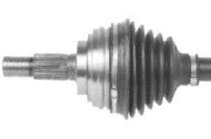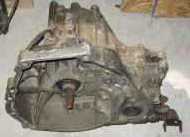
I recommend a complete new CV shaft instead of purchasing a boot kit or an individual replacement constant velocity joint kit. Removing a complete drive shaft assembly and replacing it with either a re-manufactured or new shaft assembly is the way to go. Back in the early 80s when front wheel drive was still a relatively new concept these replacement shafts were very expensive.
As a mechanic from the 80s I had replaced my share of CV boots, tripod assemblies and CV joints. In some cases special tools are needed to complete the task. In other cases when you take them apart you find that the damage is so extensive that it doesn’t make sense to rebuild the shaft. Sometimes the old one doesn’t want to come out. I recommend the slide hammer just below as it can often prevent some aggravation.
I should mention I did run into a case where the slide hammer set up did not work. Eventually we had to remove the transmission and when it did come loose it damaged the output shaft of the trans-axle. This nightmare scenario is far from common but certainly possible.
When it comes to parts many aftermarket suppliers offer a complete line of replacement drive shafts for front wheel drive vehicles. These shafts come fully assembled and are ready to install. This method eliminates the need for special axle tools and other troubles associated with rebuilding an old CV shaft.
If you just have a broken boot and you have caught the problem before any noise has developed then you may want to look into a replacement boot kit. The only advantage of a boot kit is in most cases you can replace the outside joint boot without removing the axle completely from the vehicle.
They make a CV boot replacement kit known as the speedy boot. This kit is designed for quick repairs of broken constant velocity joint boots.It is available from the most popular chain stores and can also be ordered online.
I never really liked using the speedy boot kit because it seems like cheating. To me it only makes sense on really high mileage cars that will not be around much longer. If you decide to go ahead and use one of these you’ll have to keep an eye on the axle shaft to make sure a grease leak does not develop.
Before you install a new CV shaft you have to get the old one out. Each vehicle will provide different challenges in removing the axle assembly. On some vehicles they come right out. On the other vehicles they are very difficult to remove.
This is why I recommend following the procedure outlined in your online car repair manuals. Don’t forget about that slide hammer special axle tool that works awesome for popping out a clip or snap ring retained axle shaft. If you don’t want to buy one call over to a tool rental place and see if you can rent one.
You might thank me later because as I mentioned above in one instance I found it necessary to remove the transmission from the vehicle to get a seized axle shaft to let go of the transaxle. Although this is extremely rare I just wanted to make you aware that sometimes axle shafts can be extremely difficult to remove. Generally speaking the more miles the shaft has been installed the more fight it puts up.

When you are removing the old axle shaft you want to pull on the inner part of the housing closest to the transaxle. You also want to support the outer end of the shaft so that the half shaft is in a straight line.
If you let the shaft hang on it’s own it can put weight on the retaining snap ring that holds the inner part of the joint to the transaxle. Also keep in mind that the longer the axle has been in place the harder it can be to remove. Spraying the area with penetrating oil and allowing it to soak in doesn’t hurt.
A big mistake that both professional and do-it-yourself auto mechanics make when installing the new CV shaft is they will use an air impact wrench to tighten the axle nut.
This is not the recommended procedure in the service manual. The reason being is it can cause damage to the new CV shaft and even the wheel bearings. It can also be one of the leading causes of premature failure of your new or re-manufactured parts.
You need to torque the axle nut properly and look up the specification for your specific vehicle. The torque of the outer axle nut can vary greatly from vehicle to vehicle.
I have seen foreign cars that are as low as 75 foot-pounds and some American cars that are as high as 210 foot-pounds. This last step is one of the most critical. Also keep in mind that some axle nuts are staked in place and may require a cotter pin that should come with your new CV shaft.
More information about manual drive trains and related parts can be found on this next page. You can also find more tools and information about how to deal with new cv shaft replacements.
The next link takes you back to the homepage. This is a good place to find out what else is available here and how to ask car repair questions.
Bookmark this front wheel drive shafts page, or share with a friend.


